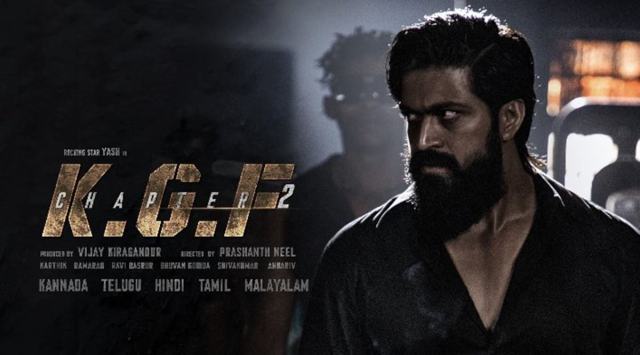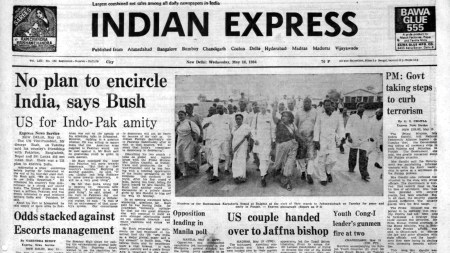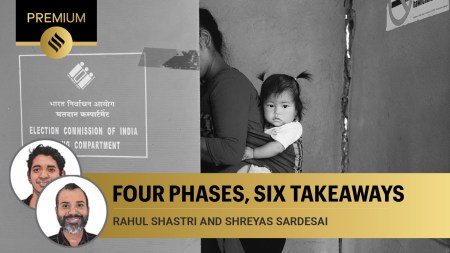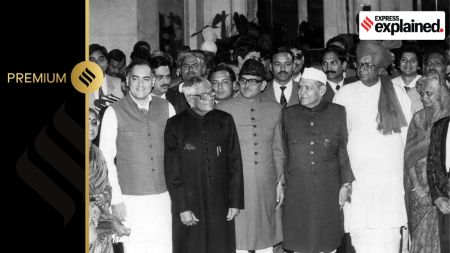- India
- International
The secret of the pan-Indian success of films from the south: Balancing the local and universal
Rajesh Rajamani writes: Bollywood has always anchored itself to an overarching ‘Indian identity’ that isn’t tied to any particular landscape. Viewers, however, want local stories that have a wider appeal.
 To decipher this new appeal of South Indian films in theatres and the OTT space, it is important to understand how Bollywood and regional cinema have positioned themselves historically. (Photo: KGFTheFilm/Twitter)
To decipher this new appeal of South Indian films in theatres and the OTT space, it is important to understand how Bollywood and regional cinema have positioned themselves historically. (Photo: KGFTheFilm/Twitter)For a long time, Indian cinema was considered synonymous with Bollywood. And regional cinema remained just that – regional, catering to specific linguistic markets. This impression existed in spite of the astounding number of films the Tamil and Telugu film industries produced regularly and their corresponding market size. But recently, there’s been a change. The pan-Indian success of South Indian regional films, like RRR, KGF: Chapter 2 and Pushpa: The Rise, has taken everyone by surprise. And what has shocked everyone is the inability of Bollywood — the latest example being the Ranbir Kapoor-starrer Shamshera — to mimic this success.
To decipher this new appeal of South Indian films in theatres and the OTT space, it is important to understand how Bollywood and regional cinema have positioned themselves historically.
Bollywood has never been rooted in any particular landscape. The industry might work out of Mumbai, but it doesn’t essentially tell the stories of Mumbaikars or even Maharashtrians. The films might be in Hindi, but the stories are rarely located in the Hindi belt. Instead, Bollywood anchors itself to an overarching “Indian identity” that isn’t tied to any particular landscape. The stories are about mythology, the freedom struggle, Hindu-Muslim relationship, India-Pakistan border conflict, NRI life, sports, underworld networks, terrorism, urban middle class problems or just Hindu cultural practices with respect to birth, marriage and death. As can be clearly seen, all these themes appeal to the nation as a whole without necessarily being rooted in a specific place. Bollywood films might have successfully projected themselves as “Indian”, but in reality, they are “land agnostic”.
On the other hand, South Indian films, whether Tamil, Telugu, Malayalam or Kannada, have predominantly been rooted in their specific geography. They tell stories that capture a certain culture, dialect, politics, social structure, and lifestyle, as can be seen in the films of Padmarajan or Bharathiraja that were set in the Malayali or Tamil milieu respectively.
However, over the last decade, with the death of the DVD/Blu-ray era and the emergence of streaming platforms, there has been globalisation in the truest sense with respect to how films are consumed, not just in India, but across the world. This new consumption pattern values local stories that are set in a particular culture but have an international appeal. Viewers don’t want to watch Indian films that look like American or French films anymore, because they might as well watch those films directly on an OTT platform. Instead, they want to watch Indian films that are rooted in a specific Indian landscape. Internationally, even the MCU or DC superhero films aren’t immune to this trend — which is why we now have the Black Panther series where the superhero’s African roots are repeatedly spotlighted.

This demand for rootedness has put South Indian films at an advantage, Because they have usually been set in a specific landscape. It must be noted, however, that the recent big budget South Indian films have been able to blend this regional rootedness with some elements inspired by Bollywood. RRR, for example, tells the story of Komaram Bheem, a revolutionary leader from the Gond tribe and Alluri Sitarama Raju, who fought for the rights of the Adivasis. But the film also finds a pan-Indian appeal for these leaders with depictions of the anti-British struggle and Hindu mythological elements. The KGF films locate themselves in the history of the Kolar Gold Fields but also borrow underworld genre elements from Bollywood. Even the upcoming Tamil film Ponniyin Selvan aspires to locate its story in the Chola period but at the same time, presents the historical fiction as one about Hindu kings and queens.
This has been true for the OTT space too. Two of the most successful Tamil films in this space, Sarpatta Parambarai and Soorarai Pottru have very local anchors. While Sarpatta Parambarai captures the boxing history in North Madras, it finds a larger appeal by being a sports genre film. In Soorarai Pottru, the real-life Brahmin protagonist Captain Gopinath is “bahujanised” to root him locally in the Tamil landscape.
South Indian regional cinema has been able to find audiences across India and even outside because of its ability to remain rooted in a certain milieu while appealing to “Indian” sensibilities. On the other hand, Bollywood films aren’t able to strike this balance because of their essential non-rootedness. Even the films that claim to go to the “hinterland” have generally only reached as far as Lucknow or Patna. Unless a new wave of filmmakers emerges to tell stories from the Hindi belt in a way that is universally appealing, it might not be easy for Bollywood to find a specific geography to which it can anchor itself. Until then, southern films will continue their pan-Indian run.
The writer is a Chennai-based filmmaker
EXPRESS OPINION
More Explained
May 17: Latest News
- 01
- 02
- 03
- 04
- 05









































